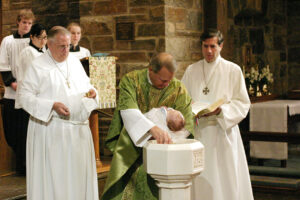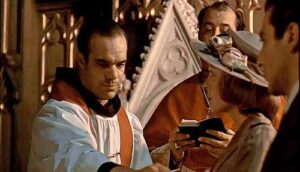BAPTISM

BAPTISM
BY WATER
Water is a symbol of regeneration as when it rains the vegetation is regenerated. By being
baptized a holy quality of spirit enters into the person making them more spiritually powerful.
Baptism is a very old rite practiced by the Hindus, Egyptians, Zoroaster, Romans, and other
nations. This was typically done by immersing the candidate in water three times while the
priest would say something like;
O Lord, this man is impure, like the mud of this stream. But do thou cleanse and deliver his
soul from sin as the water cleanses his body.
The ancient Mexicans, Persians, Hindus, and Jews before Christ had a custom of baptizing
their newborn shortly after their birth. The water represented regeneration. Paul exemplifies
the “washing of regeneration” in this verse;
He saved us not by works of righteousness which we had done, but according to His mercy,
by the washing of regeneration, and by the renewing of the Holy Ghost, Titus 3:5
The mothers of these infants by touching their infant before baptism were considered impure
and had to be presented to the priest for purity. This was done (Romans) on the eighth day
for a female and the ninth day for a male. The child’s name was announced at that time.
Jesus answered, “Verily, verily I say unto thee, unless a man be born of water and of the
Spirit, he cannot enter into the Kingdom of God. John 3:5
Every religion has their baptizing “holy” river. For the Hindus it was the Holy Granges and the
holy Sahar. For the Egyptians it was the Holy Nile. For the Chaldeans and the Persians it was
the Holy Euphrates. For the Greeks it was the Holy Lustral waters. For the Italians it was the
Holy river Po. For the Christians it was the Holy river Jordan. Elisha and Naaman used the
Jordan to wash seven times even though the Damascus river was closer and more easily
accessible. Christians also had their Holy Pool of Bethesda.
And they were baptized by him in the Jordan, confessing their sins. Matthew 3:6
DOVE DESCENDING
Ancient religions had the legend of a shape of a dove descending at baptism.
and the Holy Ghost descended in a bodily shape like a dove upon Him, and a voice came from
Heaven, which said, “Thou Art My Beloved Son; In Thee I Am Well Pleased.” Luke 3:22
The Hindus, Mexicans, Greeks, Romans, Persians, and Babylonians believed that all souls
were capable of assuming the form of a dove. At the deaths of Polycarp, Semiramis, Caesar
and others, a bodily shape of a dove was seen ascending to heaven.
The dove represented the third person of the Trinity among the ancient orientalists. The dove
is considered to be the regenerating spirit that enters into the person who is “born again,”
born into a new and holier life.

BY SPRINKLING
In areas of scarce water ways and where the rivers have fast currents and there was a fear of
immersing infants into the swift currents of the river, an alternate method of Baptism was
devised of sprinkling water on the initiate.
Blood was often substituted for water as it was deemed more symbolic producing the desired
effect. The blood was considered as the life of the soul as portrayed in the Bible. The Greeks
kept a “holy” vessel containing blood called a Facina. The Romans used a brush for applying
the blood. The Hindus and Persians used a branch for the sprinkling.
BY FIRE
This baptism was thought to impart a higher spiritual purification. This process was done by
running through flames of fire, sometimes very painfully. This practice prevailed in India,
Chaldea, Syria and throughout eastern Asia. The belief taught was that sins not expunged by
fire in this life will be punished by fire in the life to come after death.
If any man’s work shall be burned, he shall suffer loss; but he himself shall be saved, yet so
as fire. 1 Corinthians 3:15
I indeed baptize you with water unto repentance, but He that cometh after me is mightier than
I, whose shoes I am not worthy to bear. He shall baptize you with the Holy Ghost and with
fire. Matthew 3:11
BY HOLY GHOST
Here, a Priest of a high spiritual state, breathes onto or even into orifices of the person
imparting to him or her the baptism of the “Spirit of God.”
Christ practiced this when meeting with his disciples after his resurrection from the dead;
And when He had said this, He breathed on them and said unto them, “Receive ye the Holy
Ghost. John 20:22
The terms breath, air, wind, spirit, and ghost are synonymous terms that bestow the Spirit of
God as was written about the first man Adam;
And the Lord God formed man of the dust of the ground, and breathed into his nostrils the
breath of life; and man became a living soul. Genesis 2:7

FOR THE DEAD
It is customary among the Hindus as well as the Christians to postpone baptism to right
before death of the person as was done with Constantine. The reason for this is that in the
Christian faith baptism absolves one of all his or her prior sins and misdeeds no matter how
terrible those deeds were.
The problem with this is that a person might die unexpectedly before this baptism could be
performed. A method was devised to overcome this obstacle by baptizing the dead
body. This seemed not to be enough so the more common practice was devised by Saint
Chrysostom which involved a living person. The living person would go under the bed on sit
on a couch with the deceased. The priest would then ask the dead person if he would like to
be baptized. The living person would respond for the dead person. The dead corpse would
then be baptized. Paul and early Christians regarded this as an important rite.
Else, what shall they do who are baptized for the dead, if the dead rise not at all? Why are
they then baptized for the dead? 1 Corinthians 15:29
Here Paul clearly states that this practice is valid if the doctrine of the resurrection is true,
otherwise it is a senseless and superstitious practice.
RENEWING BAPTISMAL VOWS
The God Parents at the Baptism of a child answers for the child when these questions are
asked by the Priest. Later when the child is about 7 years old at the Sacrament of
Confirmation the child as an individual personally answers these questions.
Bishop:
Dear brethren, through the Paschal Mystery we have been buried with Christ in Baptism, that
we may walk with him in newness of life. And so, let us renew the promises of Holy Baptism,
which we once renounced Satan and his works and promised to serve God in the holy Catholic
Church.
And so I ask you:
Bishop: Do you renounce Satan, and all his works, and all his empty show?
God Parents: I do.

Bishop: Do you believe in God, the Father almighty, Creator of heaven and earth?
God Parents: I do
Bishop: Do you believe in Jesus Christ, his only Son, our Lord, who was born of the Virgin Mary, suffered death and was buried, rose again from the dead and is seated at the right hand of the Father?
God Parents: I do
Bishop: Do you believe in the Holy Spirit, the Lord, the giver of life, who came upon the Apostles at Pentecost and today is given to you sacramentally in Confirmation?
God Parents: I do
Bishop: Do you believe in the holy Catholic Church the communion of saints, the forgiveness of sins
the resurrection of the body, and life everlasting?
God Parents: I do
The Bishop accepts their Profession of Faith by proclaiming the faith of the Church:
This is our faith. This is the faith of the Church.
We are proud to profess it in Christ Jesus the Lord.
The whole congregation replies:
Amen.
